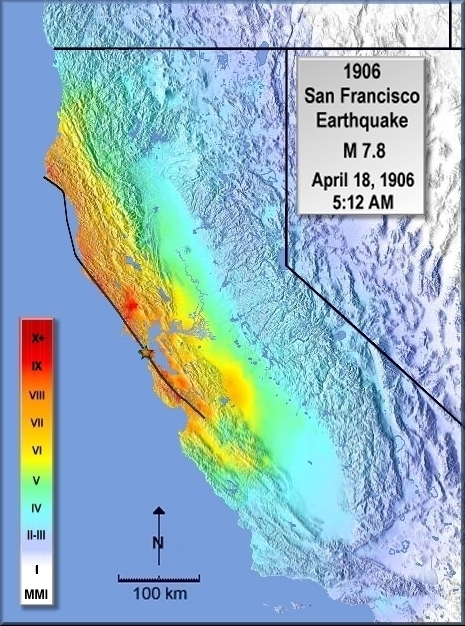What is the Mercalli Intensity Scale?
The biggest problem with the magnitude scales (the Richter scale and the Moment Magnitude) is they measure the earthquakes size and energy released, but they do not address the effects of the earthquake.
As an example, a 7.2 earthquake can cause varying degrees of damage depending on a variety of factors that determine the intensity of the quake. The worst damage of a tremor is at the epicenter, but even a large magnitude quake might cause little actual damage.
One of the biggest factors is how deep the hypocenter is. If the quake was extremely deep then the amount of damage will be much less than if it was a shallow quake. Similarly, while those at the epicenter, and in the immediate vicinity, will receive the brunt of the destruction (if any is caused), those further away will receive lesser degrees of damage. Yet, for those at the epicenter and 50 miles away it was still the same earthquake, in the case of the example it was a 7.2. Geological conditions also have an effect on the intensity of an earthquake.
The Mercalli intensity scale was created to measure the intensity and effects of an earthquake. The intensity is not completely determined by the magnitude. This scale attempts to quantify the effects on a scale from I (Roman numeral 1), where it’s not felt, to XII, which is total destruction. The values depend on distances from the epicenter, depth of the hypocenter, and data gathered from people who experienced the earthquake.
Originally developed in the late 1800’s, the scale has undergone several modifications and is known as the Modified Mercalli scale (MM) or Modified Mercalli Intensity Scale (MMI).
Using various calculations and factors, including depth and distance, the Mercalli scale may often be employed in determining earthquake scenarios and what people may experience in certain earthquake conditions.
The Mercalli intensity levels are identified by a Roman numeral, followed by a brief intensity descriptor, and then by a more detailed description of what someone might see or experience in that intensity level.
- I. Not felt -- Unlikely to be felt except by few if the conditions are right.
- II. Weak -- Only likely to be felt by a few people who aren’t doing anything, especially if they’re on the upper floors of buildings.
- III. Weak -- Most people indoors will feel the movement, particularly in the upper floors of buildings. However, most people won’t recognize the movement as an earthquake as it is similar to the vibrations felt from a passing truck. Some parked vehicles may rock slightly.
- IV. Light -- Most people indoors will feel it, and a few outside. During the night the movement may wake some people up. Windows, doors, and dishes will shake lightly. Parked vehicles will be noticeably rocked.
- V. Moderate -- Almost everyone will feel it, and if asleep many will be woken up. Can break windows with the shaking and unstable objects may fall.
- VI. Strong -- Everyone feels it, and it’s enough to frighten many. The shaking can move furniture, damage plaster, and can cause slight damage.
- VII. Very strong -- Poorly built or designed buildings will receive considerable damage. Well-built structures may receive slight to moderate damage. Buildings of better design and construction may only receive negligible damage.
- VIII. Severe -- Specially designed building receive slight damage, while considerable damage occurs in ordinary structures. Poorly build buildings will receive severe damage. Chimneys, factory stacks, monuments, and walls may fall. Heavy furniture may be overturned.
- IX. Violent -- Buildings may be shifted from foundations. Liquefaction can occur. Substantial damage to buildings as well as partial collapse. Specially designed buildings will receive considerable damage.
- X. Extreme -- Some well-built wood structures may survive, while most frame and masonry buildings and foundations are destroyed. Railroad tracks are bent.
- XI. Extreme -- Few masonry structures survive. Bridges are destroyed and underground pipes are out of service. Railroad tracks get severely bent. Soft ground will cause land slips, and fissures will open.
- XII. Extreme This is total destruction. Ground waves may be seen. Objects may be thrown into the air.
Using these intensity values, and factors that affect the earthquake's effect on the surface, a very deep (something like more than 100 miles (160km)) 7.2 earthquake may only have an Mercalli value of IV or V. But the same magnitude tremor that's shallow (less than 43 miles or 70 km) might bump the intensity value to VII or VIII.
The following image is a Modified Mercalli Intensity map for the great San Francisco earthquake of April 18, 1906.
The map is color coded from intensity scale I to X+. While everyone in the area experienced a 7.8 earthquake, they didn't all experience the same intensity.
At the time the Richter scale was in use, but the shaking effects of the quake didn't fit the Richter's Modified Mercalli Intensity scale. After the quake the the intensity scale was revised.



Comments
Post a Comment